Bulletin – June 2014 Australian Economy Foreign Investment in Residential Real Estate
- Download the article 573KB
Abstract
The available data, while incomplete, suggest that for much of the past decade or so approvals granted for foreign investment in the residential sector have remained around 5–10 per cent of the value of dwelling turnover in Australia, and perhaps half that share of the total number of dwellings turned over. The actual level of foreign purchases of dwellings has been significantly lower. Foreign purchases appear to be most concentrated in new rather than established dwellings, in higher- rather than lower-priced dwellings, in medium- and high-density dwellings rather than detached dwellings, and in inner-city areas of Sydney and Melbourne rather than other locations.
Introduction
While most housing transactions in Australia are between domestic residents, foreign residents also participate, both as developers and purchasers of dwellings. This article summarises the Bank's recent Submission to the House of Representatives Economics Committee Inquiry into Foreign Investment in Residential Real Estate. The article outlines the legislative framework for foreign residential investment in Australia and the data available on the flow of foreign investment. While incomplete in several regards, these data suggest that foreign residential purchases have fluctuated a bit from year to year but remained relatively low as a share of housing turnover measured by both value and number, and that foreign demand is more concentrated in some parts of the housing market than in others. On balance, foreign residential demand has probably resulted in an increase in the supply of dwellings in Australia by more than would otherwise have been the case, and hence stimulated construction activity. However, the inherent sluggishness of the housing supply response suggests that some of the increase in foreign demand for housing may have spilled over into higher prices, especially for higher-priced dwellings.
Legislative Framework and Available Data
Australia's foreign investment laws seek to channel foreign residential activity into new dwellings to promote local construction. The laws cover three broad groups: foreign developers of new residential projects; foreign purchases of new dwellings; and temporary resident purchases of new and established dwellings. In short:
- foreign-developed new residential projects are permitted and the resultant dwellings can be sold to either foreign or domestic buyers
- foreign individuals and temporary residents are permitted to purchase any new dwelling
- temporary residents with visas that allow them to stay in Australia for a continuous period of more than 12 months (such as some foreign students and people on skilled business visas) are permitted to purchase one established home provided it is used as their principal place of residence while in Australia and is sold once vacated.[1]
Foreign investors and temporary residents require approval from the Foreign Investment Review Board (FIRB) prior to purchasing a dwelling or site for development, and most such applications are approved. FIRB is also responsible for monitoring compliance, and to this end works with relevant members of the business community, government authorities, legal community and other government agencies (such as the Department of Immigration and Border Protection, Australian Taxation Office, Australian Securities and Investments Commission and the Federal Police). To strengthen the administration and oversight of the regulations, foreign purchase rules were tightened in 2010 and data-matching was expanded using FIRB data, state and territory lands and property office transaction data and citizenship data. The penalties for not seeking prior approval can be substantive.[2]
FIRB publishes data annually on the total number and value of the approvals it grants to foreign investors and temporary residents for the purchase of a specifically identified property or piece of land (the latest annual data available cover 2012/13, although data covering the first three quarters of 2013/14 were published recently). Setting aside any potential under-reporting to FIRB, these data are likely to represent an upper limit on the actual level of foreign investment in Australia, since not every approval granted by FIRB results in a property sale to a foreign investor or temporary resident. In particular, there is no adjustment made to the published approvals data as to whether the proposed purchases were subsequently completed (i.e. whether a bidder was successful at an auction, a contract to purchase a specified home was completed, or a proposed residential development project was built). In addition, foreign or domestic developers of some proposed new residential projects can receive pre-approval from FIRB to sell up to 100 per cent of the resultant dwellings to non-residents, after which no further approval from the individual buyers is required. As a consequence, the published FIRB data do not reflect the share of new residential dwellings in these projects that was actually sold to foreign citizens or temporary residents or the timing as to when the sales took place. Perhaps, more importantly, the FIRB data published reflect only gross approvals by foreign buyers; the subsequent sale of their properties to Australian citizens or permanent residents (required for instance when temporary residents vacate the property) is not included in the FIRB data. Other limitations of the FIRB data include the lag in their availability as well as series breaks (such as the changes to reporting requirements in 2009 and 2010 for dwelling purchases by temporary residents).
Despite these limitations, the FIRB approvals are the main source of data on the level of foreign residential investment in Australia. While there are published surveys of real estate agents' views on the share of foreign investment, it is not clear how the agents distinguish between sales to foreign investors, Australian expatriates, permanent residents or Australian citizens when completing these surveys. In addition to the FIRB data, this article draws on information gathered through the Bank's liaison with housing market contacts; it does not discuss residential purchases made by permanent residents and citizens of Australia.
Recent Trends in Foreign Residential Investment
While volatile from year to year, the FIRB data indicate that the value of approved foreign investment in residential property in Australia has increased, rising from around $6 billion annually in the 1990s to more than $17 billion in 2012/13 (Graph 1). This increase has been driven mainly by approvals for new dwelling purchases and construction – which account for the bulk of the approvals granted – though approvals to purchase established dwellings have also increased over time off a very low base. However, with national dwelling prices and turnover having increased significantly over the past 20 years, the value of foreign residential approvals as a share of total dwelling turnover in Australia has not increased over time, fluctuating around 5–10 per cent, and in 2012/13 it was in the middle of that range.[3] Recently published data indicate that there has been a marked rise in approvals for new dwelling purchases during the first three quarters of 2013/14, with the value of total foreign approvals as a share of dwelling turnover in Australia increasing to over 12 per cent. Over the past decade, there has been an increase in approvals to purchase established dwellings, although these approvals remain only 3 per cent of the value of total dwelling turnover.
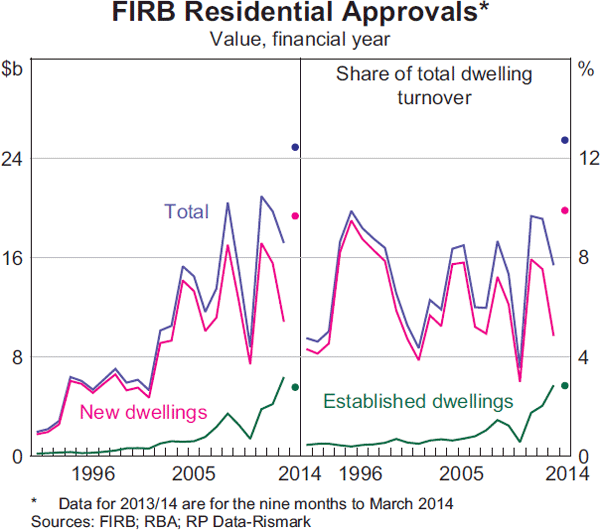
FIRB also publishes the number of foreign approvals each year. Focusing first on the approvals granted to foreign individuals and temporary residents to purchase a particular dwelling, the data indicate that while the number of both new and established dwelling approvals have increased over time – especially recently – they are still each around 2 per cent or less of the number of total dwellings turned over in Australia (Graph 2). There is some additional turnover associated with the approvals granted to residential developers, although their number is difficult to estimate from the available data and depends very much on the assumptions used. FIRB grants just a single approval to a developer to cover the purchase of land that can be subsequently subdivided for the development of multiple dwellings, and also grants a single approval for developers who apply to sell some or all dwellings in a new residential project to non-residents, such as for a new higher-density building. Using recent information on the historical average number of dwellings built in these types of approved projects (around 170 dwellings per building; see Australian Treasury (2014)), and assuming as an upper limit that approval was sought for 100 per cent of the dwellings completed in these projects to be available for sale to foreign or temporary residents, then the approvals associated with these residential projects may have added a further 2–3 per cent or so to the foreign share of dwellings turned over in Australia.
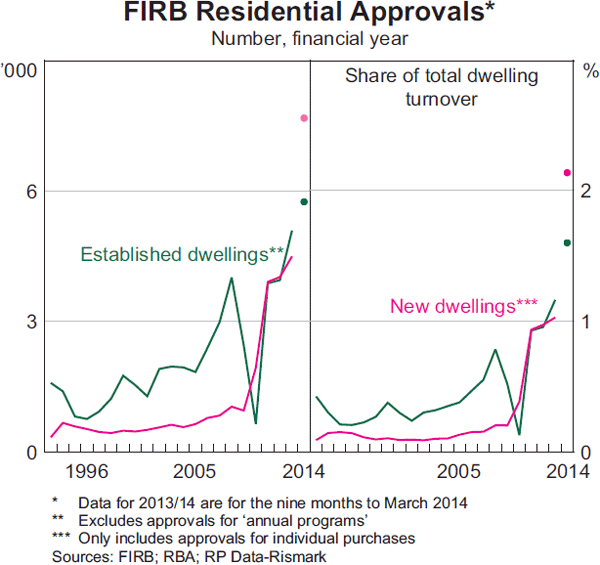
However, for the reasons noted earlier, FIRB's approvals-based data overstate the actual share of dwellings purchased by foreign citizens and temporary residents in Australia. For instance, while approval can be sought to sell up to 100 per cent of completed dwellings in a new residential project, a recent FIRB report noted that typically only around 35 per cent of the dwellings in such projects are actually sold to foreign citizens and temporary residents (Australian Treasury 2014). The share of sales to foreign and temporary citizens would be lowered further if an adjustment were made for the approvals granted by FIRB for foreign individuals to purchase a dwelling but which did not subsequently lead to an actual sale, though this share cannot be determined from the available data.
Overall, the available data suggest that while foreign residential purchases change a bit from year to year, they have been relatively steady and fairly low as a share of turnover in the housing market in Australia and hence are unlikely to have been the main driving factor behind the recent increase in prices, notwithstanding the pick-up in approvals more recently. Nonetheless, there is evidence that foreign purchases play a more prominent role in some parts of the housing market than in others. Focusing on approved purchases by individuals of new and established dwellings, the FIRB data indicate that the average purchase price in 2012/13 was around $650,000 for a new dwelling and around $1 million for an established home. For both new and established dwellings, the average prices for approved purchases have consistently been much higher than the average sales price nationally (Graph 3). Taken at face value, this suggests that purchases by foreign and temporary residents tend to be concentrated in the higher-priced parts of the housing market, although it is possible that this average is elevated somewhat by a few approvals to purchase very high-priced homes.
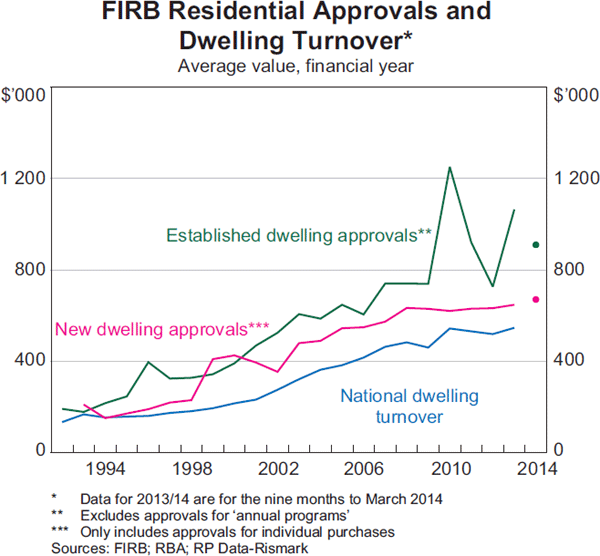
Moreover, the FIRB approvals data suggest that foreign investment in new dwellings is concentrated in New South Wales and Victoria. In 2012/13, investment in new dwellings in these two states accounted for almost four-fifths of the total value of foreign residential investment approvals, much larger than the three-fifths share that these states have in the overall stock of housing in Australia (Graph 4). Bank liaison with industry participants suggests that much of this investment has been for the purchase of higher-density dwellings located in inner-city areas of Sydney and Melbourne, as foreign buyers and temporary residents typically prefer dwellings close to the central business districts, major universities and public transport infrastructure. Nonetheless, there is some evidence from the Bank's liaison with residential builders that foreign investment has started to broaden out into other areas of Sydney and Melbourne and, to a lesser extent, to other state capitals. The data for approvals to purchase established dwellings are more evenly distributed among the states.
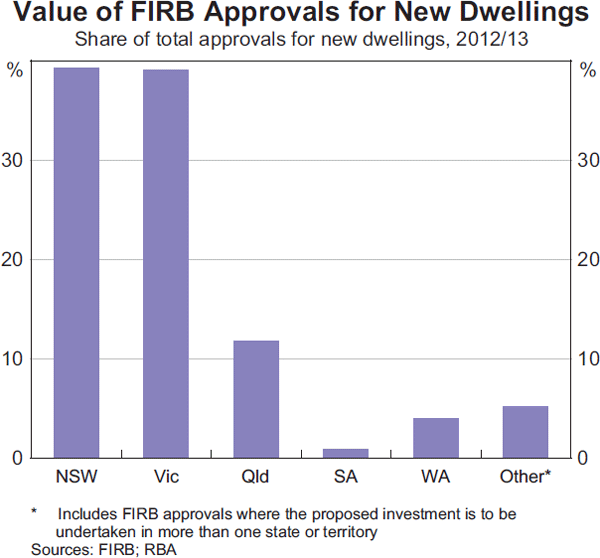
Bank liaison with housing market contacts suggests that, rather than being for short-term speculative purposes, foreign purchases of dwellings in Australia generally reflect a decision to invest for the longer term. In particular, these purchases appear to be motivated to meet housing needs for business persons located temporarily in Australia, for children studying in Australia, to acquire a second residence (possibly for eventual migration) and/or to diversify holdings of wealth geographically. There is little indication from the Bank's liaison with industry contacts that the level of foreign demand for Australian housing is significantly affected by fluctuations in the exchange rate, except perhaps for a few high-priced homes.
Economic Effects of Foreign Residential Investment
An increase in the level of demand for new or established Australian dwellings is likely to lead eventually to an increase in housing supply, although the increase in supply may ultimately not be in the same location because of constraints on land availability. In this respect, the key issue is the flexibility of housing supply in terms of its quantum and timeliness. Previous Bank research has suggested that supply impediments in the housing construction market have been significant in some states – reflecting the lack of suitable brownfield and greenfield land for development, difficulties in planning coordination, and resistance by local residents to new housing projects – which have added to the time taken to build and to the cost of new housing (Hsieh, Norman and Orsmond 2012). More recent Bank liaison with housing participants suggests that the coordination of planning processes in some greenfield land areas has improved, though other rigidities remain.[4] In this regard, the recent interest in converting older office buildings in the CBDs to higher-density residential buildings may help to offset the shortage of land available in well-located areas of the capital cities. Nonetheless, to the extent that the housing supply response is inherently sluggish, an increase in housing demand – be it from foreign or domestic sources – will increase dwelling prices, at least temporarily until higher prices induce an increase in housing supply.
Whether the purchase of a property by a foreign citizen represents an increase in overall demand for housing in Australia depends on a number of factors. For example, if the dwelling is purchased to house a child studying in Australia who would otherwise have had to rent a home, or if the property bought by a foreign citizen is subsequently rented out, then the purchase itself does not represent an addition to demand for housing. Conversely, if a new dwelling is kept vacant after being purchased by a foreign citizen then there will be a net increase in demand for housing. The overall impact on the housing market of ownership by foreign citizens also depends not only on their purchases, but on their subsequent sales. If the flow of purchases and sales by foreign citizens roughly balance, then there is likely to be little effect on overall demand and house prices from foreign participation in the housing market. Furthermore, it is important to note that purchases of dwellings by foreign citizens and temporary residents who subsequently become permanent residents have simply shifted forward their demand for a home. While there are no comprehensive data on how foreign residential investment is divided between all these various categories, it seems likely that there has been some net increase in demand for housing by foreign citizens and temporary residents given the increase in wealth over recent decades of countries relatively close to Australia. It is also worth noting that some Australian citizens purchase property in other countries, which may reduce their demand for property in Australia.
Some commentators have noted the potential for foreign residential demand to push up the price of housing for first home buyers. However, the data available – while incomplete – suggest that first home buyers have generally purchased established rather than new dwellings, and purchased dwellings that are cheaper than the national average (Graph 5 and Graph 6). As noted earlier, both of these are parts of the overall housing market where foreign residential purchasers do not appear to have a major presence.[5] While state incentives for first home buyers have recently shifted toward the purchase of new rather than established dwellings – and hence to the area of the housing market where foreign buyers generally have a greater presence – the degree of competition with foreign buyers is still likely to be fairly small.
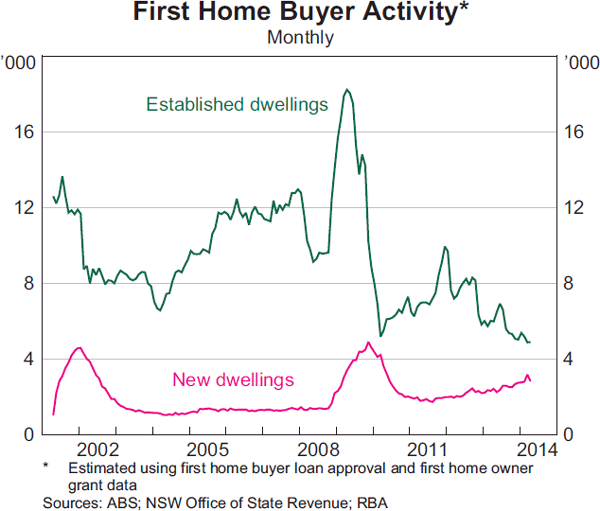
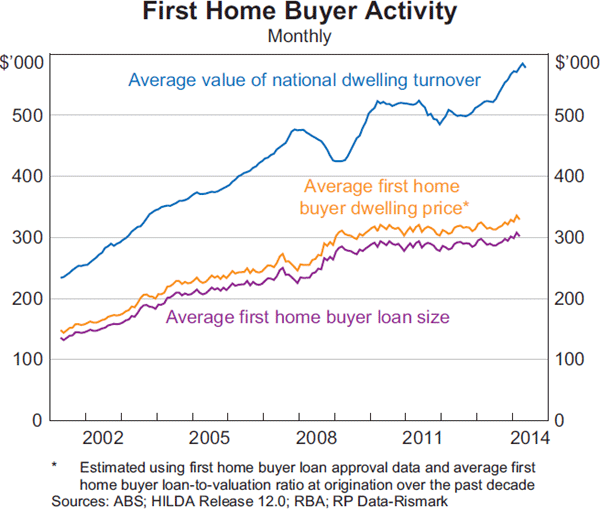
In addition, some of the foreign residential investment has been associated with the large increase in the number of temporary students in Australia during the 2000s, and more broadly with the increased integration of Australia with economies in emerging Asia, which is boosting income and activity throughout the economy. This effect seems likely to continue for an extended period as the number of people in the middle class in Asia increases.
As a consequence of these various effects, foreign demand for Australian dwellings can – and has – provided a stimulus to the local residential construction industry, which accounts for around 9 per cent of total employment in the Australian economy and is more labour intensive than most other industries (Graph 7 and Graph 8). In addition, to the extent that materials used in the construction industry are sourced domestically, an increase in residential building supports local suppliers of building materials and can boost demand for household durable goods. The Bank's liaison contacts report that foreign residential demand has been especially helpful in boosting construction activity in the current stage of the economic cycle. In recent years, developers have reported little difficulty sourcing the skilled labour required for the construction of new dwellings, especially given the decline in investment in the mining industry that is freeing up some construction labour.
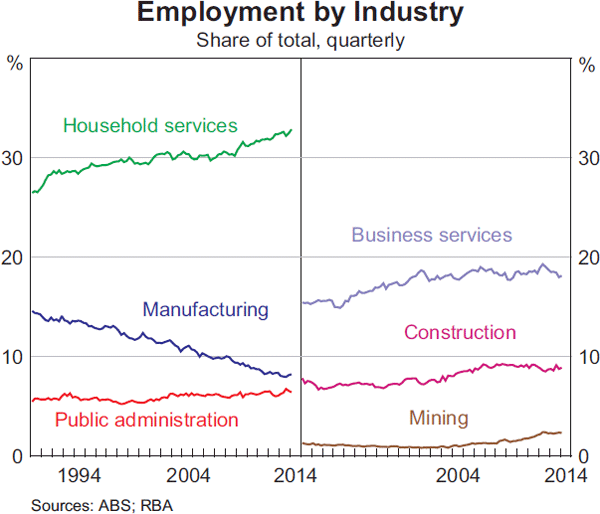
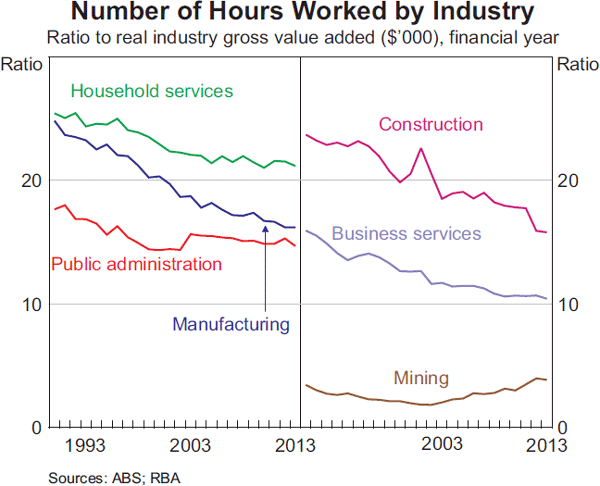
The impact of foreign residential developers in adding to the overall supply of new dwellings in Australia is more difficult to determine, although on balance it is probably positive. In principle, the residency of a developer should make little difference to the magnitude of the supply response following an increase in demand for new housing. In practice, foreign developers may introduce new technology and skills to the Australian market and increase competition. In addition, foreign developers often fund projects using offshore financing, which diversifies the source of funding and at times may increase the overall level of funds available for dwelling investment in Australia. Finally, foreign developers often market their projects to potential buyers located in their own home country, which may at the margin increase the level of foreign demand for Australian dwellings and hence construction activity over what it would otherwise have been.
Nonetheless, dwelling purchases and development by foreign residents can increase the exposure of the Australian housing market to business cycles offshore. This may amplify Australia's business cycle to the extent that economic cycles are synchronised globally, but may act to dampen the effect on local activity to the extent that business cycles are idiosyncratic across countries. Further, unlike domestic developers, foreign developers often try to pre-sell a large share of new dwellings to non-residents and may therefore have to substantially increase the number of dwellings for sale in Australia should these foreign purchase intentions not be followed through.[6] In addition, as for any net capital inflow, foreign-financed residential investment may increase the value of the Australian dollar, although these inflows appear to have been relatively small to date.
International Comparisons
Foreign participation in the housing market has not been limited to Australia. For many decades, non-residents have purchased homes in global cities such as London and New York. According to industry reports, in most English-speaking countries – including Canada, New Zealand, the United Kingdom and the United States – there are very few restrictions on foreign purchases of residential property. Unlike Australia, these countries appear to make little-to-no differentiation between foreign purchases of new or established dwellings and there are very few reporting requirements. More recently, partly in recognition of the current weak activity in their housing markets, European governments have been looking at ways to increase foreign residential investment from outside the European Union. The situation in Asia varies across economies: for instance, Hong Kong and Malaysia have comparatively minimal restrictions on foreign investment in their new and established housing markets – though some economies have increased property taxes in an effort to slow the pace of house price growth – while in China, India and Indonesia, non-residents are generally not permitted to purchase residential property.
Conclusions
Foreign investment has been a longstanding feature of Australia's housing market, with the available data suggesting that while foreign purchases change a bit from year to year, they have generally remained low as a share of the total value and number of houses turning over. Nonetheless, the data on foreign purchases are limited, and a case could be made to publish more granular – and more timely – statistics, especially data that are already being collected by FIRB. The benefits of any additional reporting requirements would need to be carefully balanced against the added administrative burden. The data and liaison suggest that foreign residential investment is concentrated in some parts of the housing market, though not generally in the parts where first home buyers have a major presence. While it is difficult to know the counterfactual, purchases by foreign residents and construction by foreign developers have probably resulted in a somewhat higher stock of housing in Australia than would otherwise have been the case, although by a magnitude that is difficult to determine.
Footnotes
The authors are from Economic Analysis Department. [*]
Foreign-owned companies can also purchase established properties to house their Australian-based staff; for a full set of definitions and the legal restrictions and allowances, see the Foreign Investment Review Board website (www.firb.gov.au). [1]
People who do not seek approval for foreign investment in Australia can face a fine of up to $85,000 and two years jail, and the Treasurer has the right to order the sale of an acquisition that was not in the national interest. There have been some reports in the media of foreign citizens purchasing established properties through family and friends who already have Australian residency, in which case the FIRB approvals data for this category would understate the level of ‘effective’ foreign investment; it is difficult to determine the extent of any such purchases. [2]
These estimates effectively assume that the year in which a residential construction project is approved by FIRB aligns with the year that the consequent dwellings are sold. [3]
More broadly, a range of structural factors related to Australia's urban environment impede the flexibility of housing supply; for a detailed discussion, see RBA (2014). [4]
Bank liaison suggests that some foreign purchases of inner-city apartments close to universities are to house foreign students studying in Australia; anecdotal reports suggest that these properties are not a large part of the first home buyer market for Australian citizens. [5]
Local developers usually cap the share of foreign buyers at around 20–40 per cent of total sales, partly reflecting limits placed by Australian banks; the cap is reportedly much higher for some foreign-developed projects. [6]
References
Australian Treasury (2014), ‘Submission to the Inquiry into Foreign Investment in Residential Real Estate’, Submission to the House of Representatives Standing Committee on Economics, May, p 6.
Hsieh W, D Norman and D Orsmond (2012), ‘Supply-side Issues in the Housing Sector’, RBA Bulletin, September, pp 11–19.
RBA (Reserve Bank of Australia) (2014), ‘Submission to the Inquiry into Affordable Housing’, Submission to the Senate Economics References Committee, 14 February.